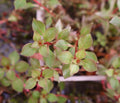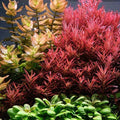Caring for Red Root Floaters
Red root floater care is simple to handle, whether you are an expert hobbyist or a complete beginner at aquascaping. One of the simpler aquatic plants to grow and take care of is this one.
Despite this, there are still certain fundamentals to go through. Although the red root floater can adapt to most aquarium settings, following the suggestions listed below will give it the best chance to grow.
Tank Volume
Red root floaters can be rather versatile because they adjust to the size of the aquarium. Because of this, we suggest you grow them in a tank that can hold at least five gallons.
Instead of concentrating on depth, consider length and width for the greatest visual impact. A long tank would be excellent. Of course, if you have fish in your aquarium, their requirements should come first.
Despite popular opinion, this plant doesn't require a very deep tank to thrive. They can develop on muddy surfaces in the wild!
Parameters for water
This blushing-red plant is extremely versatile and thrives in a variety of environments. That's just one of the numerous factors that make caring for red root floaters so easy.
It is usually desirable to mimic a plant's natural growing environment as closely as possible. To do it, concentrate on tropical biotypes. The water needs to be nutrient-rich and warm.
Unlike some other plants, the red root floater does not require CO2, yet it can still profit from organic nutrients like iron. Just make sure that any aquatic animals you have in the tank are safe around the fertilizers!
The red root floater requires the following fundamental conditions to survive. Make sure the tank has very little water flow in addition to the following: The growth cycle will only be disturbed by strong currents.
Water between 70°F and 82°F
pH ranges from 6.5 to 7.5 (neutral conditions).
Hardness of water: 0 to 30 dHG
Lighting
For red root floater plants to thrive, a typical day/night cycle is necessary. The bare minimum amount of light is between six and eight hours!
You can also increase the exposure to achieve the desired look.One of the many reasons this plant is so well-liked is that it can be illuminated to create any desired appearance.
The leaves are still an intense shade of green in low to medium sunlight. The plant may have a few red hints around the margins, but under normal lighting conditions, it appears to be a common floater.
Increase the light it receives to bring out the red coloration. The distinctive flushing red color of the leaves is caused by high lighting.
Substrate
Red root floaters don't need any substrate, which is wonderful news!
This plant, as we've already established, is floating. The root system never touches the bottom and remains hanging in the water.
Red root floaters can now occasionally grow in mud and sand-based soils. Therefore, you shouldn't be concerned about this in a conventional aquarium environment.
Tips for Planting It
Placing the young plant in your aquarium is all that is required to start the red root floater. Most pet stores sell them as little root masses the size of a penny. Only two or three leaves may be present on them.
The plant will grow and spread quickly if the water is in the proper conditions.
Don't forget to quarantine the plant before putting it in your tank. Never introduce a red root floater or any plant without first quarantining it in your primary tank.
This is because some plants may have chemicals like pesticides or preservatives that are bad for fish.
Even worse, some hitchhikers might be staying there. One of the most typical ways aquarists add pest snails, parasites, and predatory insects into the mix is through infected plants.
















